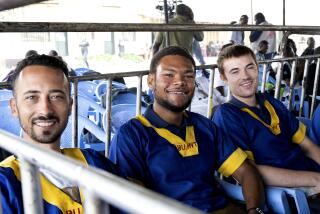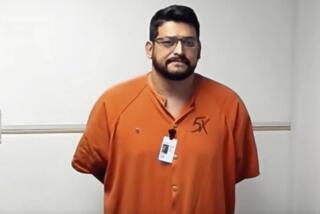Gunman Found Guilty of Trying to Kill Clinton
WASHINGTON — Rejecting claims that his actions resulted from mental illness, a federal jury Tuesday convicted Francisco Martin Duran of attempted assassination of President Clinton and nine other weapon-related charges for spraying the White House with semiautomatic rifle fire last October.
A jury of 10 women and two men deliberated only five hours before convicting the former Colorado hotel worker. U.S. District Judge Charles R. Richey set sentencing for June 29. U.S. Atty. Eric H. Holder Jr. told reporters that prosecutors will recommend punishment ranging from 25 years to life imprisonment.
Duran, 26, wearing an open-collared white shirt and dark slacks, sat impassively at the defense table as Richey announced the verdict. The defendant was promptly escorted from the courtroom by federal marshals.
Holder, outside the courthouse, said the jury’s verdict reaffirms the findings of federal investigators that Duran’s actions in firing 25 to 30 rounds at the White House from a sidewalk crowded with tourists “resulted from his antisocial behavior, and he should be held responsible for it.”
Holder said the verdict should send “a strong and clear message” to others who might think of harming the President. It also demonstrates the importance of others coming forward who hear of threats against public officials, as some of Duran’s co-workers did only belatedly, he said.
Duran did not testify at his two-week trial, which included more than 50 witnesses from the ranks of law enforcement officers, tourists, psychiatrists and his former associates.
Medical specialists called by Duran’s attorney, federal public defender A. J. Kramer, said that the defendant showed symptoms of being a paranoid schizophrenic who suffered from hallucinations and voices inside his head. He reported seeing the vision of an evil “mist” hanging over the White House a moment before he started shooting, they said.
Government psychiatrists disagreed with these findings, asserting that Duran had a personality disorder but was not insane. Dr. Raymond Patterson, former director of the District of Columbia’s mental hospital, told the jury that Duran has “a long-term chronic maladaptation to life” and was lying about visions to avoid prosecution.
The Duran verdict ran counter to the controversial finding of a jury 13 years ago in the case of John W. Hinckley Jr., who was charged with attempting to murder President Ronald Reagan outside a Washington hotel. Jurors found Hinckley not guilty by reason of insanity, and he remains confined at St. Elizabeth’s Hospital in Washington.
Since then, however, Congress has tightened federal statutes to make insanity defenses more difficult to prove.
*
At Hinckley’s trial, federal prosecutors had the burden of proof to show that Hinckley was sane, that he could determine right from wrong and that he could control his behavior. Now the legal burden is on the defense to prove insanity “by clear and convincing evidence.” The defense also must show that the accused has a serious mental illness--not just a personality defect--that prevents him from knowing right from wrong. There no longer is any behavioral standard.
Assistant U.S. Atty. Eric Dubelier, the lead prosecutor, told jurors that Duran’s claim of mental illness was “just nonsense.”
“The man’s faking. He knows this is his only way out,” Dubelier said in his closing argument.
Shortly after the Oct. 29 shooting, authorities said Duran had fired randomly and that the President was never in any danger. Clinton was in the rear living quarters of the White House watching a Saturday afternoon college football game on television.
But a joint investigation by the Secret Service, the FBI and the Bureau of Alcohol, Tobacco and Firearms turned up notes Duran left at his Colorado Springs home shortly before beginning a monthlong odyssey in September. In the notes, he threatened to harm the President. Former co-workers at the Broadmoor Hotel there also testified that Duran was a hate-filled anarchist who had vowed to kill Clinton.
Prosecutors showed that after standing outside the White House fence for six hours, Duran began firing a Chinese-made assault-style weapon, which had been concealed beneath his trench coat, when he spotted a New York businessman on the grounds who strongly resembled the President.
Dubelier explained to jurors that even though Clinton was not endangered, a person can be convicted of attempted assassination if he acts with intent to harm the President.
More to Read
Sign up for Essential California
The most important California stories and recommendations in your inbox every morning.
You may occasionally receive promotional content from the Los Angeles Times.










